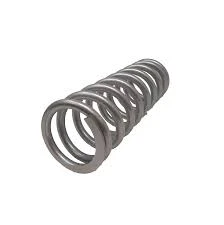
- Mobile Phone
- +8613931874955
- sales@cntcmetal.com
Design and Functionality of a Dual Conical Compression Spring Mechanism
The Double Conical Spring An Ingenious Design in Mechanics
The double conical spring, an innovative component in mechanical engineering, showcases a unique design that allows for enhanced performance in various applications. This spring shape is characterized by its conical ends that taper towards the center, resulting in a distinctive double-ended cone structure. This configuration provides several advantages over traditional cylindrical springs, making it a popular choice in numerous mechanical systems.
One of the primary benefits of the double conical spring is its ability to accommodate space constraints. Since the ends are narrower than the center, these springs can fit into tighter spaces while still providing effective mechanical support. This is especially valuable in industries such as automotive engineering, aerospace, and robotics, where space optimization is crucial. The reduced height and compact design mean that double conical springs can be integrated into systems without sacrificing performance.
Moreover, the double conical design allows for progressive spring characteristics. Unlike uniform cylindrical springs that exhibit a constant spring rate, double conical springs can provide varying resistance based on compression. As the spring is compressed, the coils at the narrower ends come into contact earlier, adding to the overall stiffness without overwhelming the system. This feature enables more precise control over mechanical systems such as suspension systems, where gradual resistance is essential for optimal performance.
double conical spring

Another significant advantage of double conical springs is their ability to handle lateral loads effectively. The conical shape provides stability and minimizes buckling under eccentric loading conditions, making them ideal for applications where misalignment can occur. This robustness enhances the longevity and durability of the components in which they are installed.
In addition to their mechanical properties, the manufacturing process of double conical springs has seen advancements that contribute to their appeal. Modern materials and production techniques, such as advanced metallurgy and precise CNC machining, allow for high-quality springs with improved fatigue resistance and consistency. This ensures that they can withstand repeated stress and perform reliably over time.
In conclusion, the double conical spring represents a remarkable evolution in spring design. Its compact structure, progressive characteristics, and robust performance under lateral loads make it an invaluable component in a wide array of mechanical applications. As industries continue to seek efficiency and precision, the double conical spring will undoubtedly play a vital role in the advancement of engineering solutions and innovations. The ongoing research and development surrounding this spring type promise even further improvements and applications in the future.
share:
-
Your Source for Concrete Wall Ties and Masonry AccessoriesNewsJul.10,2025
-
Unlocking the Power of Iron Wire for Every ProjectNewsJul.10,2025
-
Explore Advanced Chain Wire and Stainless Steel Mesh FencingNewsJul.10,2025
-
Discover the Benefits of Annealed Wire ProductsNewsJul.10,2025
-
Discover China Stainless Steel Wire Mesh SolutionsNewsJul.10,2025
-
Build with Confidence Using High-Performance Masonry AccessoriesNewsJul.10,2025
-
Why Sacrificial Formwork Is Redefining Underground ConstructionNewsJun.06,2025



















